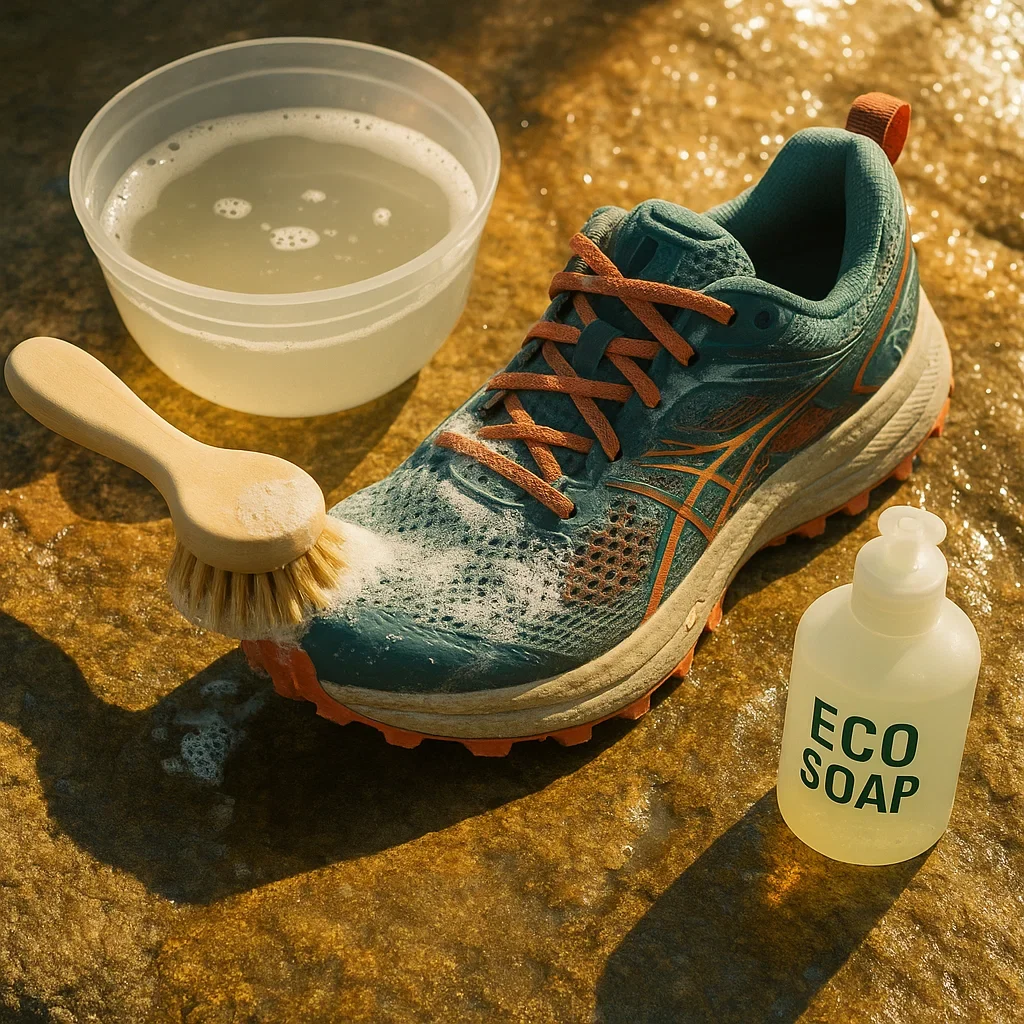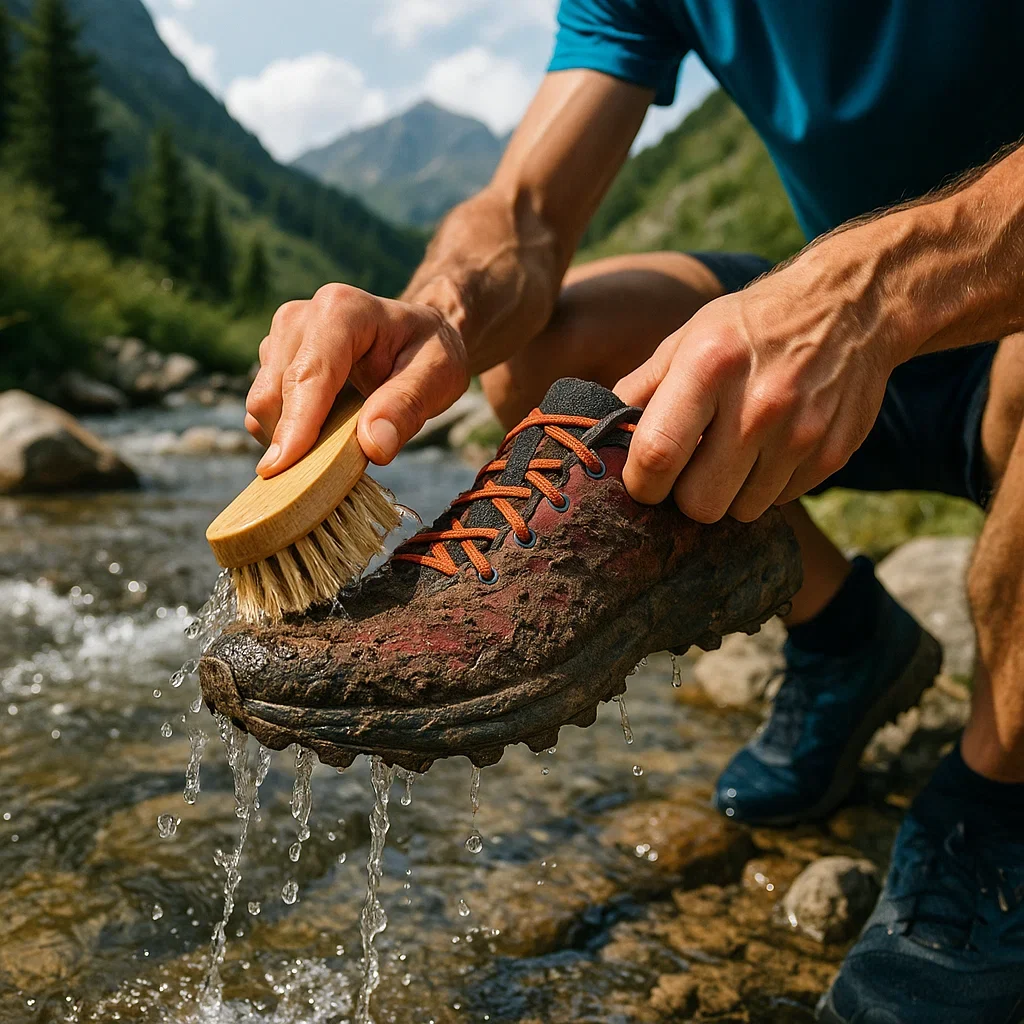Trail running shoes are built for abuse—mud, water crossings, technical terrain. But the same tech that gives you energy return and grip is shockingly vulnerable to bad washing habits. A single wrong wash can collapse foam, peel seams, and shorten shoe life by hundreds of kilometers.
In this guide, you’ll learn how to safely hand-wash your trail shoes for maximum comfort, longevity, and race-day performance. We’ll break down:
- Why washing machines and hot water can destroy EVA, TPU, and PEBA midsoles
- The right soaps and techniques for foam-safe cleaning
- Step-by-step hand-wash protocol, drying, and deep-clean tricks
- Odor/stain solutions and what to do if your shoes are already “dead”
- Pro tips for extending shoe life between washes
Fact: Modern trail shoe foams can lose up to 15% bounce after just one hot machine cycle. The best runners hand-wash—here’s how.
🧪 Types of Midsole Foam & Their Sensitivity to Washing
- EVA (Ethylene Vinyl Acetate): Most common; light and springy. But absorbs water, loses structure with heat, and is sensitive to strong detergents.
- TPU (Thermoplastic Polyurethane): Durable, bouncy, less prone to compression, but heavy and slow to dry. Can harden or warp in hot water.
- PEBA (Polyether Block Amide): “Superfoam” (e.g., Nike ZoomX, Saucony PWRRUN PB). Feather-light, best bounce, but expensive and extra sensitive to solvents/heat.
- PU (Polyurethane): Found in heavier models. Longest lifespan, but can dry-rot if left damp or unwashed for long periods.
Bottom line: All modern foams are vulnerable to hot water, harsh chemicals, and rough mechanical action. The hand-wash method below keeps your shoes bouncy and supportive for the long run.
🫧 Step-by-Step Safe Hand-Wash Protocol
- Remove insoles & laces: Take them out for separate cleaning and to allow every part of the shoe to dry.
- Knock off debris: Use a stick or brush to remove dry mud, pebbles, and grit from the outsole and upper.
- Prepare a wash solution: Fill a bucket with lukewarm (not hot!) water. Add 1 tsp gentle, fragrance-free soap or a foam-safe shoe cleaner.
- Gently scrub: Use a soft nylon brush or old toothbrush. Focus on upper mesh, midsole creases, and lugs. Rinse brush frequently.
- Rinse thoroughly: Dunk shoes in clean, lukewarm water or spray with a low-pressure shower until no soap remains.
- Dry smart: Stuff with newspaper or microfiber towels. Air dry in shade—never use direct sun, radiator, or tumble dryer. Replace paper every 2–3 hours. Optional: use a fan for better airflow.
- Wash insoles separately with the same mild solution; air dry flat.
- Clean laces in soapy water, rinse and air dry (never use bleach).
Pro tip: For heavy stains, use a baking soda paste or a splash of white vinegar (max 1% dilution). Rinse thoroughly after.

🗓️ How Often Should You Wash Trail Shoes?
Over-washing shortens shoe life, but neglect leads to stink, mold, and foam breakdown. Use the guide below to time your cleaning routine:
Spot clean between full washes—focus on insoles and laces for quick freshness.
🏆 Pro Tips to Extend Shoe Life
- Rotate pairs: Always alternate two or more trail shoes. Foam recovers 2–5% extra bounce after 24–48 hr rest.
- Inspect midsole compression: Measure midsole height (heel/forefoot) monthly—retire if permanent “flattening” exceeds 15%.
- Air out after every run: Remove insoles and laces—even if you don’t wash, this prevents hidden moisture and odor.
- Store smart: Keep shoes upright, out of direct sunlight and humidity. Never leave in a car trunk or gym bag overnight.
- Patch early: Use Shoe Goo or Tenacious Tape for small tears or loose seams before they spread.
- Emergency field hack: No fan or dry spot? Fill with dry rice, silica gel packs, or even dry tea bags overnight.
Pro tip: Never run with soaking wet shoes more than one day—foam will break down much faster if left soggy!
❓ FAQ – Trail Shoe Washing
Can I ever use a washing machine?
It’s not recommended. Only use cold water, no spin, pillowcase bag, and air-dry—still risky for foam and glue.
What water temperature is safe?
Lukewarm (≤ 30°C) is optimal—never hot or boiling water.
Which soap should I use?
Mild, fragrance-free dish soap or a foam-safe technical cleaner. Avoid bleach, harsh detergents, and alcohol.
Can I dry shoes in the sun?
No—UV damages glue, mesh, and foam. Always air-dry in the shade with good airflow.
How do I remove tough mud stains?
Use a baking soda paste, gentle scrubbing, and a soft brush. Avoid hard-bristled brushes and solvents.
Is it OK to use vinegar for odor?
Yes, up to 1% dilution is safe for foam and adhesives—always rinse thoroughly.
How do I know when shoes are clean enough?
No visible mud, sand, or soap residue. Mesh and lugs should feel fresh, not sticky or gritty.
How do I dry insoles and laces?
Lay insoles flat and air-dry; hang laces. Avoid heat sources for both.
How often should I wash trail shoes?
After every muddy/wet run; otherwise every 3–5 uses. See the frequency table above for details.
Does frequent washing reduce shoe life?
Only if you use wrong technique! Gentle hand-washing and smart drying can double foam and seam life.
📚 Further Reading
🧩 Quick Quiz: Are You a Foam-Safe Washing Pro?
- What’s the safest water temperature for trail shoe washing?
- Name a foam-safe detergent or DIY cleaning recipe.
- What’s the fastest way to dry shoes without damaging foam?
- Which types of foam lose bounce fastest if machine-washed?
- True/False: You can use bleach on trail shoes if well diluted.
✅ Answers
- Lukewarm (≤ 30°C)
- Grangers, Nikwax, or 1 tsp dish soap + 1 tsp vinegar (≤1%) in 1L water
- Stuff with newspaper/towel and air-dry in shade; add a fan if needed
- EVA and PEBA
- False (never use bleach)
🎯 Final Thoughts
With just a little extra care, your trail shoes can outlast harsh terrain, rainy seasons, and ultra-distance training. Every gentle hand-wash, every fresh insole, every patch means more strong miles and less gear waste.
Got a favorite washing hack or disaster story? Share it below and help others avoid costly mistakes!

About the Author
Lost Pace is an ultramarathon runner, shoe-tester and the founder of umit.net. Based year-round in Türkiye’s rugged Kaçkar Mountains, he has logged 10,000 + km of technical trail running and completed multiple 50 K–100 K ultras.
Blending mountain grit with data, Lost analyses power (CP 300 W), HRV and nutrition to craft evidence-backed training plans. He has co-written 260 + long-form guides on footwear science, recovery and endurance nutrition, and is a regular beta-tester of AI-driven coaching tools.
When he isn’t chasing PRs or testing midsoles, you’ll find him sharing peer-reviewed research in plain English to help runners train smarter, stay healthier and finish stronger.
Ultrarunner · Data geek · Vegan athlete


🚀 Share This Guide